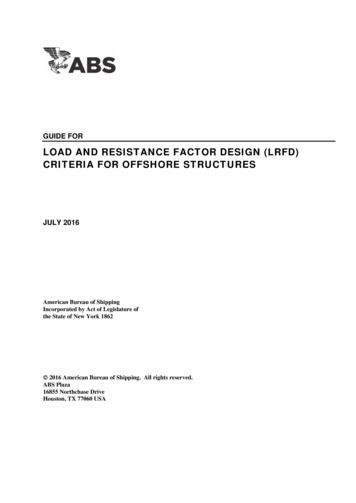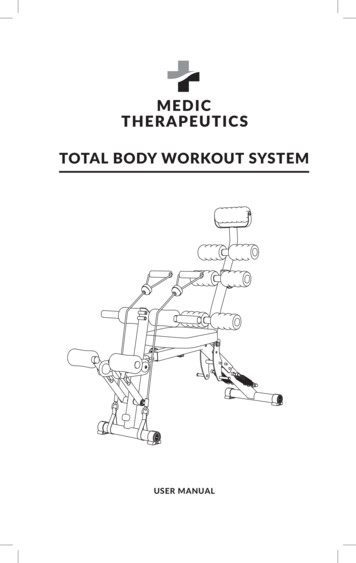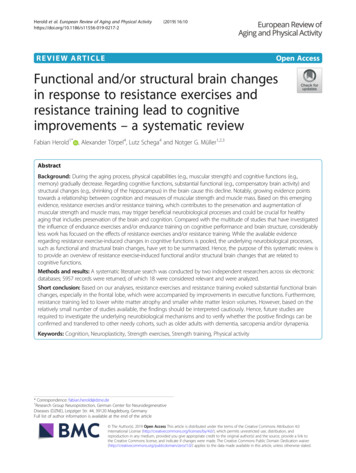
Transcription
Guide for Load and Resistance Factor Design (LRFD) Criteria for Offshore StructuresGUIDE FORLOAD AND RESISTANCE FACTOR DESIGN (LRFD)CRITERIA FOR OFFSHORE STRUCTURESJULY 2016American Bureau of ShippingIncorporated by Act of Legislature ofthe State of New York 1862 2016 American Bureau of Shipping. All rights reserved.ABS Plaza16855 Northchase DriveHouston, TX 77060 USA
ForewordForewordThis Guide provides structural design criteria in a Load and Resistance Factor Design (LRFD) format forspecific types of Mobile Offshore Drilling Units (MODUs), Floating Production Installations (FPIs) and MobileOffshore Units (MOUs). The LRFD structural design criteria in this Guide can be used as an alternative tothose affected criteria in Part 3 of the ABS Rules for Building and Classing Mobile Offshore Drilling Units andPart 5B of the ABS Rules for Building and Classing Floating Production Installations, where the criteria arepresented in the Working Stress Design (WSD) format, also known as the Allowable Stress (or Strength)Design (ASD) format.This Guide becomes effective on the first day of the month of publication.Users are advised to check periodically on the ABS website www.eagle.org to verify that this version ofthis Guide is the most current.We welcome your feedback. Comments or suggestions can be sent electronically by email to rsd@eagle.org.iiABS GUIDE FOR LOAD AND RESISTANCE FACTOR DESIGN (LRFD) CRITERIA FOR OFFSHORE STRUCTURES . 2016
Table of ContentsGUIDE FORLOAD AND RESISTANCE FACTOR DESIGN (LRFD)CRITERIA FOR OFFSHORE STRUCTURESCONTENTSCHAPTER 1General . 1Section 1Introduction . 2Section 2Principles of the LRFD Method . 6CHAPTER 2Structural Design of Mobile Offshore Units . 8Section 1General Design Considerations . 12Section 2Common Structures . 22Section 3Self-Elevating Units . 33Section 4Column-Stabilized Units . 42CHAPTER 3Structural Design of Floating Production Installations . 50Section 1General Design Considerations . 53Section 2Column-Stabilized Installations . 64Section 3Spar Installations . 75ABS GUIDE FOR LOAD AND RESISTANCE FACTOR DESIGN (LRFD) CRITERIA FOR OFFSHORE STRUCTURES . 2016iii
This Page is Intentionally Left Blank
Chapter 1: GeneralCHAPTER1GeneralCONTENTSSECTION 1Introduction . 21Scope of This Guide . 23Applications . 25Terms and Definitions . 375.1Terminology. 35.3Abbreviations. 4References . 4TABLE 1SECTION 2References of LRFD and WSD Structural Design Criteria . 2Principles of the LRFD Method . 61LRFD Criteria Format. 63Limit States . 65Load Categories. 77Resistances . 7ABS GUIDE FOR LOAD AND RESISTANCE FACTOR DESIGN (LRFD) CRITERIA FOR OFFSHORE STRUCTURES . 20161
Section 1: ope of This GuideThis Guide provides structural design criteria in a Load and Resistance Factor Design (LRFD) format forspecific types of: Mobile Offshore Drilling Units (MODUs) addressed in the ABS Rules for Building and Classing MobileOffshore Drilling Units (MODU Rules) Floating Production Installations (FPIs) in the ABS Rules for Building and Classing Floating ProductionInstallations (FPI Rules) Mobile Offshore Units (MOUs) in the ABS Guide for Building and Classing Mobile Offshore Units(MOU Guide)The applications of this Guide to specific types of MODUs, MOUs and FPIs are defined in 1-1/3.General principles of the LRFD-based design are described in Chapter 1, Section 2. The LRFD-based structuraldesign criteria are specified in Chapters 2 and 3.3ApplicationsThe LRFD-based structural design criteria in this Guide can be used as an alternative to those affected criteriain Part 3, Chapter 2 of the MODU Rules and Part 5B of the FPI Rules, where the criteria are presented inthe Working Stress Design (WSD) format, also known as the Allowable Stress (or Strength) Design (ASD)format. 1-1/Table 1, below, summarizes the applications of the LRFD-based structural design criteria specifiedin this Guide as well as the corresponding WSD-based criteria in the MODU Rules and the FPI Rules. TheWSD and LRFD versions of structural design criteria are considered equally valid, and either may be used tosatisfy part of the ABS classification requirements. However, except as directed herein, it is not permissibleto mix parts of the WSD and LRFD criteria.TABLE 1References of LRFD and WSD Structural Design CriteriaType of StructuresMODU orMOU (1)LRFD CriteriaWSD CriteriaSelf-Elevating (Drilling) UnitThis Guide: Chapter 1, andChapter 2 Sections 1 and 2MODU Rules: Part 3, Chapter 1 andSections 3-2-1, 3-2-2 and 3-2-3Column-Stabilized (Drilling) UnitThis Guide: Chapter 1, andChapter 2 Sections 1 and 3MODU Rules: Part 3, Chapter 1 andSections 3-2-1, 3-2-2 and 3-2-4Column-Stabilized InstallationThis Guide: Chapter 1, andChapter 3 Sections 1 and 2FPI Rules: Section 5B-1-1 and 5B-1-2Spar InstallationThis Guide: Chapter 1, andChapter 3 Sections 1 and 3FPI Rules: Sections 5B-3-1, 5B-3-3,5B-3-4 and 5B-3-5FPI (2)Notes:21The definitions of MODU and MOU and the specific types of these Units referenced in the table can be found inPart 3, Chapter 1 of the MODU Rules and Chapter 2 of the MOU Guide.2The definitions of FPI and the specific types of FPIs referenced in the table can be found in Part 5B Chapters 1 and 3of the FPI Rules.ABS GUIDE FOR LOAD AND RESISTANCE FACTOR DESIGN (LRFD) CRITERIA FOR OFFSHORE STRUCTURES . 2016
ChapterSection11GeneralIntroduction1-1The structural design criteria of this Guide, the MODU Rules and the FPI Rules rely on references to otherstandards, in particular the ABS Guide for Buckling and Ultimate Strength Assessment for OffshoreStructures (Buckling Guide). ABS has issued different WSD and LRFD versions of the Guide for Bucklingand Ultimate Strength Assessment for Offshore Structures. Only the version of the Guide that is compatiblewith the selected format of structural design criteria is to be used.5Terms and DefinitionsFor the purpose of this Guide, the following terms and definitions apply. Additional applicable terms anddefinitions can be found in the MODU Rules, the FPI Rules, and the MOU Guide.5.1Terminology5.1.1Characteristic ValueA value of load or resistance established with respect to a prescribed probability of not being violatedby an unfavorable value.5.1.2Design ValueA value of load or resistance obtained from a representative value that has been modified by theappropriate load or resistance factors.5.1.3Factored LoadThe representative value of a load multiplied by a load factor, which may be greater than, less than,or equal to 1.0.5.1.4Factored ResistanceThe representative value of a resistance divided by a resistance factor usually greater than 1.0.5.1.5Limit StateA state beyond which the structure, or some part of the structure, no longer fulfils specified designcriteria5.1.6Load EffectAn effect of a load on the structure, for example, internal forces, internal moments, stresses, strains,rigid body motions, and elastic deformations.5.1.7Nominal ValueA value of load or resistance that may not have a statistical basis. It is based on applicable experienceor is obtained from a recognized reference standard or recognized code (i.e., criteria mandated bythe cognizant governmental authority).5.1.8Representative ValueA value of load or resistance that is used to verify the limit state. The representative value can be acharacteristic or nominal value or other rationally determined value of the variable. The representativevalue of a load can relate to upper or lower bound characteristic values.5.1.9ResistanceThe capacity of a structural component, the cross-section of a component, or a structural detail towithstand the effects of loads.5.1.10 Unfactored (Load or Resistance)Where the load or resistance factor to be applied is 1.0.ABS GUIDE FOR LOAD AND RESISTANCE FACTOR DESIGN (LRFD) CRITERIA FOR OFFSHORE STRUCTURES . 20163
tionsABSAmerican Bureau of ShippingAISCAmerican Institute of Steel ConstructionALSAccidental Limit StateAPIAmerican Petroleum InstituteASDAllowable Stress (or Strength) DesignFPIFloating Production InstallationFLSFatigue Limit StateISOInternational Organization for StandardizationLRFDLoad and Resistance Factor DesignMOUMobile Offshore UnitMODUMobile Offshore Drilling UnitNACENational Association of Corrosion EngineersSLSServiceability Limit StateULSUltimate Limit StateWSDWorking Stress DesignReferencesReferences are made in this Guide to ABS Rules and other criteria issued by ABS and other organizations.Unless otherwise noted, the applicable edition of a reference is the one officially issued and available onthe date the Agreement for Classification is accepted by ABS. Where a particular edition or date associatedwith a reference is given, it means that particular edition is relevant to the topic being presented in this Guide.Use of a later edition may be permitted upon consultation with ABS. ABS may consider at its discretion,upon the request of the Owner, the application of other appropriate alternative methods and recognizedcodes of practice.4i)ABS Rules for Building and Classing Floating Production Installations (FPI Rules)ii)ABS Rules for Building and Classing Mobile Offshore Drilling Units (MODU Rules)iii)ABS Guide for Building and Classing Mobile Offshore Units (MOU Guide)iv)ABS Rules for Conditions of Classification – Offshore Units and Structures (Part 1)v)ABS Rules for Materials and Welding (Part 2)vi)ABS Rules for Building and Classing Steel Vessels (Steel Vessel Rules)vii)ABS Guide for Buckling and Ultimate Strength Assessment for Offshore Structures (LRFD Version)(LRFD Buckling Guide)viii)ABS Guide for Certification of Lifting Appliances (Lifting Appliance Guide)ix)ABS Guide for the Class Notation Coating Performance Standard (CPS)x)ABS Guide for the Fatigue Assessment of Offshore Structures (Fatigue Guide)xi)ABS Guidance Notes on the Dynamic Analysis for Self-Elevating Unitsxii)AISC Specification (LRFD), Specification for Structural Steel Buildings, ANSI/AISC-360-10,2010 (Only the LRFD formatted criteria are relevant to this Guide)xiii)API RP 2A-LRFD, Recommended Practice for Planning Designing and Constructing Fixed OffshorePlatforms – Load and Resistance Factor Design, First Edition, 1993, and Supplement 1, 1997ABS GUIDE FOR LOAD AND RESISTANCE FACTOR DESIGN (LRFD) CRITERIA FOR OFFSHORE STRUCTURES . 2016
ChapterSection11GeneralIntroduction1-1xiv)API Specification 2C, Specification for Offshore Pedestal Mounted Cranesxv)ISO 19902, Petroleum and natural gas industries – Fixed steel offshore structures, 2007xvi)ISO 19904-1, Petroleum and natural gas industries – Floating offshore structures – Part 1:Monohulls, semi-submersibles and spars, 2006xvii)ISO 19905-1, Petroleum and natural gas industries – Site-specific assessment of mobile offshoreunits – Part 1: Jack-ups, 2012ABS GUIDE FOR LOAD AND RESISTANCE FACTOR DESIGN (LRFD) CRITERIA FOR OFFSHORE STRUCTURES . 20165
Section 2: Principles of the LRFD MethodCHAPTER1GeneralSECTION2Principles of the LRFD Method1LRFD Criteria FormatIn the framework of LRFD-based design method, the adequacy of a design is verified by demonstrating thatthe effects of the factored loads do not exceed the factored resistance for each limit state under consideration.The factored loads are normally defined through a combination of the representative values of loads in variousload categories modified by relevant load factors. Load factors can be greater than, less than, or equal to 1.0.The effects of the factored loads are the responses of the structure subjected to the factored loads. Thestructural responses are typically expressed in the form of, for instance, internal forces, internal moments,stresses, strains, rigid body motions, and elastic deformations.The factored resistance is the representative value of the resistance divided by a resistance factor usuallygreater than 1.0.3Limit StatesA limit state is defined as a condition beyond which a structure, or some part of the structure, exceeds aspecified design criterion. The common limit states in structural design are those for: serviceability, ultimateresistance to loads (i.e., strength), fatigue endurance, and the ability of the structure to survive an accidentalevent. Accordingly, these limit states are referred to by the names Serviceability Limit State (SLS), UltimateLimit State (ULS), Fatigue Limit State (FLS), and Accidental Limit State (ALS).i)Ultimate Limit State (ULS) – The ultimate limit state relates to conditions when a structure losesits ability to carry load in the manner assumed in the structural design and analysis. The ultimatelimit state can occur due to yielding or buckling.ii)Fatigue Limit State (FLS) – The fatigue limit state relates to the failure of a structural componentdue to cyclic load effects leading to fracture.iii)Accidental Limit State (ALS) – The accidental limit state relates to criteria to be satisfied for specifieddamage conditions.iv)Serviceability Limit State (SLS) – The serviceability limit state primarily deals with issues that couldaffect such things as: appearance, comfort, excessive deformations, etc. These are not ordinarilywithin the scope of Classification as described in the MODU Rules or the FPI Rules. General guidanceon SLS is provided in Chapter 2 and Chapter 3 of this Guide.The limit states related to ultimate strength, fatigue resistance and accidental conditions (ULS, FLS andALS) are those addressed in this Guide.6ABS GUIDE FOR LOAD AND RESISTANCE FACTOR DESIGN (LRFD) CRITERIA FOR OFFSHORE STRUCTURES . 2016
ChapterSection512GeneralPrinciples of the LRFD Method1-2Load CategoriesThe main load categories are referred to by the symbols D, L, E, and S for Permanent, Variable, Environmental,and Supplementary loads, respectively. The use of the symbols D and L for Permanent and Variable loadsreflects common usage in many other standards for offshore structures, such as those published by API andISO. Historically, the Permanent and Variable load categories were respectively called Dead and Live loads;hence the symbols D and L.In LRFD criteria, different load factors may be applied to these different categories of load. The Permanentand Variable load categories comprise the gravitational loads, and there may be different load factors assignedto these load categories for the different required design load combinations.7ResistancesResistance is the capacity of a structural component, the cross-section of a component, or a structural detailto withstand the effects of loads.The resistances of steel structural components, as considered herein for ULS and ALS, are based on the usualassumption of linear elastic behavior with modifications to account for inelastic effects in buckling and plasticbehavior of a member’s cross-section.The resistance of a steel structural detail to fatigue fracture, as considered herein for FLS, is most commonlyestablished in terms of the S-N curve approach coupled with a linear cumulative damage method(Palmgren-Miner’s Rule).The values for structural responses and resistances are assumed to be calculated independently. In the casewhere non-linear analysis is used and structural responses and resistances are calculated simultaneously,equivalent levels of safety to those implicit in this Guide are to be maintained.ABS GUIDE FOR LOAD AND RESISTANCE FACTOR DESIGN (LRFD) CRITERIA FOR OFFSHORE STRUCTURES . 20167
Chapter 2: Structural Design of Mobile Offshore UnitsCHAPTER2Structural Design of Mobile Offshore UnitsCONTENTSSECTION 1General Design Considerations . 121Structural Analysis .123SECTION 281.1Analysis of Primary Structure . 121.3Consideration of Local Load Effects . 121.5Combination of Load Effect Components . 121.7Consideration of Buckling . 121.9Determination of Bending Stresses . 131.11Determination of Shear . 131.13Stress Concentration . 131.15Analysis and Details of Structural Connections . 131.17Fatigue Analysis . 131.19Plastic Analysis . 14Load and Resistance Factor Design Criteria .143.1General . 143.3Limit States . 143.5Load Categories . 143.7Resistances . 173.9Design Conditions for LRFD . 173.11Format of LRFD Criteria . 183.13Load Factors, Resistance Factors and Load Combinations . 193.15Equivalent Stress Criterion for Plated Structures . 203.17Representative Values of Loads . 21TABLE 1Structure Load Combinations and Corresponding LoadFactors (γf) and Resistance Factors (γR) forSelf-Elevating Units .19TABLE 2Structure Load Combinations and Corresponding LoadFactors (γf) and Resistance Factors (γR) forColumn-Stabilized Units .20TABLE 3Structure Load Combinations and Corresponding LoadFactors (γf) and Resistance Factors (γR) for CommonStructures .20TABLE 4Representative Values of Loads .21Common Structures . 221General .221.1Materials . 221.3Scantlings . 221.5Protection of Steel Work . 22ABS GUIDE FOR LOAD AND RESISTANCE FACTOR DESIGN (LRFD) CRITERIA FOR OFFSHORE STRUCTURES . 2016
3Helicopter Deck. 225Structures Supporting the Drilling Derrick. 23791113SECTION 35.1Substructures . 235.3Substructure Supporting Arrangement . 23Watertight Bulkheads and Watertight Flats . 237.1General. 237.3Plating . 237.5Stiffeners and Beams . 247.7Corrugated Bulkheads . 267.9Girders and Webs . 277.11Openings . 27Tank Bulkheads and Tank Flats . 289.1General. 289.3Plating . 289.5Stiffeners and Beams . 299.7Corrugated Bulkheads . 299.9Girders and Webs . 299.11Drainage and Air Escape. 30Appurtenant Structure . 3011.1General. 3011.3Lifeboat Platform . 3111.5Crane Pedestal and Foundation . 3111.7Pipe Racks . 31Higher-strength Materials. 3113.1General. 3113.3Watertight Bulkheads and Flats and Tank Bulkheads and Flats . 31TABLE 1Thickness and Flange Width of Brackets and Knees . 25TABLE 2Values of Q. 32FIGURE 1Corrugated Bulkhead . 26FIGURE 2Corrugated Bulkhead End Connections . 26Self-Elevating Units. 331Application . 333General Requirements for Materials and Scantlings . 3353.1Material Selection and Welding . 333.3Scantlings . 33Units Elevated Modes . 335.1General. 335.3Safety Against Overturning. 335.5Wave Clearance . 345.7Preload . 345.9Wave-Induced Dynamic Responses . 34ABS GUIDE FOR LOAD AND RESISTANCE FACTOR DESIGN (LRFD) CRITERIA FOR OFFSHORE STRUCTURES . 20169
7Legs .357.1Legs in Elevated Condition . 357.3Legs in Transit Condition . 369Hull Interface Structure with Legs .3711Hull Structure .3713Spudcan and Bottom Mat .37151713.1Spudcan . 3713.3Bottom Mat . 38Deckhouses .3915.1General . 3915.3Design Head . 3915.5Plating. 3915.7Stiffeners . 4015.9House Sides . 4015.11End Attachment . 4015.13Racking Resistance . 40Structures Supporting the Drilling Derrick.40FIGURE 1SECTION 4Column-Stabilized Units . 421General .4235710Typical Hull Construction .411.1Application . 421.3Scantlings and Special Considerations Regarding Stresses . 421.5Effect of Mooring Forces on Local Structure . 421.7Material Selection and Welding . 42Upper Structure .423.1General . 423.3Deck Plating . 433.5Beams . 433.7Girders . 443.9Stanchions and Pillars . 443.11Non-buoyant Upper Structure Not Subjected to Wave Loading . 453.13Buoyant Upper Structure . 453.15Upper Structure Subjected to Wave Loading . 45Columns, Lower Hulls, and Footings .455.1General . 455.3Scantlings of Framed Shells . 465.5Scantlings of Unframed Shells . 465.7Scantlings of Structural Flats . 465.9Additional Structural Requirements . 465.11Bracing Members. 475.13Openings in Columns . 47Deckhouses .477.1General . 477.3Storage Tanks on Upper Structure . 48ABS GUIDE FOR LOAD AND RESISTANCE FACTOR DESIGN (LRFD) CRITERIA FOR OFFSHORE STRUCTURES . 2016
911Wave Clearance . 489.1Afloat Modes of Operation . 489.3On-Bottom Modes of Operation . 48Structural Redundancy . 4811.1Assumed Damage . 4811.3Analysis . 4811.5Upper Structure . 4813Structures Supporting the Drilling Derrick. 4915Higher-strength Materials. 4915.1General. 4915.3Upper Structure . 49ABS GUIDE FOR LOAD AND RESISTANCE FACTOR DESIGN (LRFD) CRITERIA FOR OFFSHORE STRUCTURES . 201611
Section 1: General Design ConsiderationsCHAPTER2Str
the Working Stress Design (WSD) format, also known as the Allowable Stress (or Strength) Design (ASD) format. 1-1/Table 1, below, summarizes the applications of the LRFD-based structural design criteria specified in this Guide as well as the corresponding WSD-based criteria in the











